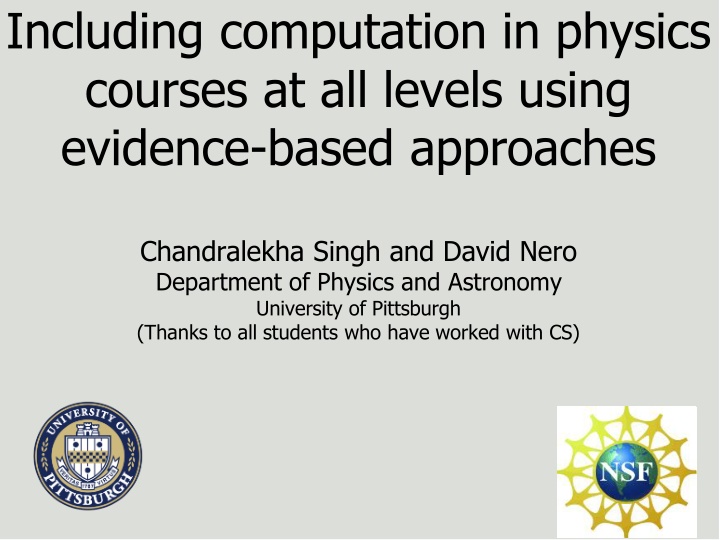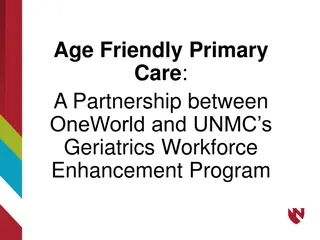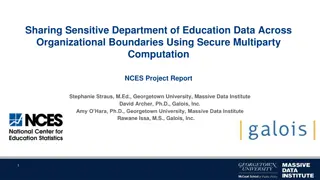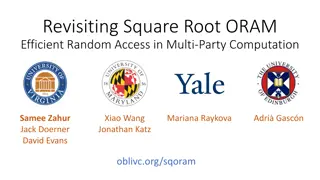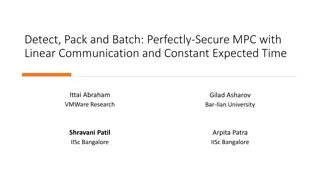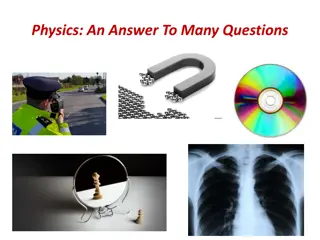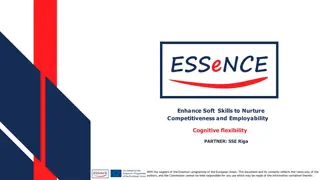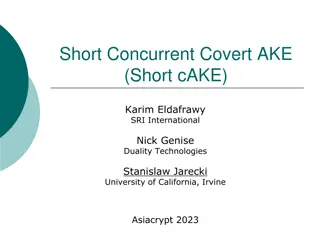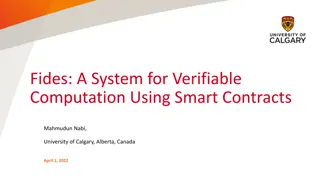Enhancing Computation in Physics Education Using Cognitive Approaches
Utilizing evidence-based methods, this study explores incorporating computation in physics courses, focusing on instructional design, student knowledge states, and preparation for future learning. It discusses common conceptual difficulties in quantum mechanics and proposes cognitive theory-based strategies to improve student understanding. The aim is to guide students from initial knowledge states to enhanced comprehension through effective pedagogical techniques.
Download Presentation

Please find below an Image/Link to download the presentation.
The content on the website is provided AS IS for your information and personal use only. It may not be sold, licensed, or shared on other websites without obtaining consent from the author.If you encounter any issues during the download, it is possible that the publisher has removed the file from their server.
You are allowed to download the files provided on this website for personal or commercial use, subject to the condition that they are used lawfully. All files are the property of their respective owners.
The content on the website is provided AS IS for your information and personal use only. It may not be sold, licensed, or shared on other websites without obtaining consent from the author.
E N D
Presentation Transcript
Including computation in physics courses at all levels using evidence-based approaches Chandralekha Singh and David Nero Department of Physics and Astronomy University of Pittsburgh (Thanks to all students who have worked with CS)
Cognitive Approach to Instructional Design (Reif) Student's knowledge state Performance Pretest, interviews Pi Si Assessment Instruction Posttest, interviews Pf Sf Goal of instruction: Guide students from Si-> Sf Sfdepends on Siand instructional design Alignment of Learning objectives-instructional design-assessment
Preparation for Future Learning Bransford and Schwartz (1999) - innovation vs. efficiency Innovation: creativity of problem forces cognitive engagement and learning, but too innovative = too hard (outside Vygotsky s zone of proximal development) Too much struggle may inhibit problem engagement and learning Efficiency: easy to follow, but low cognitive engagement Highly innovative -too hard Innovation low cognitive engagement-disengagement Efficiency
Preparation for Future Learning For effective transfer or good preparation for future learning Need elements of both innovation and efficiency Optimal for transfer good preparation for future learning Too hard Innovation Doesn t stick Efficiency
Improving Student Understanding of QM *Students have common conceptual difficulties in QM independent of background, teaching style & textbook *Commonality of difficulties originate from Difficulty discriminating between related concepts tendency to over-generalize *Strikingly similar to "universal" nature of difficulties in introductory physics *Students are developing expertise in a new domain
How to improve student understanding? Cognitive theory suggests new knowledge builds on prior knowledge Must know student s initial knowledge and build on it Difficulties related to a particular topic can be classified into a few categories People s sense making shows patterns Students must construct their own understanding Effective pedagogical strategies engage students in the learning process (cognitive apprenticeship model) Provide systematic tasks consistent with current knowledge
Quantum Interactive Learning Tutorials (QuILTs) Cognitive approach to instructional design *well-defined learning goals *Use student difficulties in learning QM as a guide *Guided inquiry-based learning sequences- builds on student prior knowledge Hints and feedback provided as needed *Bridge the gap between quantitative and conceptual aspects of QM *Use computer-based visualization tools (mostly adapted from OSP simulations by Belloni and Christian) *Keep students actively engaged *Each tutorial comes with pre-test/post-test
Time-Evolution QuILT (Sims: Belloni and Christian) *Equal-mix superposition in the ISW shown with a variety of visualizations.
Evaluation Tutorial % Pretest Score % Post-test Score Time development of wave function 53 85 Uncertainty principle 42 83 Mach-Zender interferometer 48 83 Stern-Gerlach Experiment 55 86 Drawing Wavefunction 40 90 Measurement 67 90 Addition Angular Momentum 35 74 Quantum Key Distribution 56 91
Computational Methods (PHYS 1321) in a Flipped Format Computational Methods in Physics in a Flipped Format -Learn basics skills in coding in a programming language (Python) -Use it to solve a variety of physics problems -Do two longer term projects (midterm and final) collaboratively in small groups -Develop a portfolio -Make sure this course does not disadvantage those with no coding experience
Motivation Computational Methods (PHYS 1321) in a Flipped Format Demographics The class was originally envisioned as suitable for sophomore year. Roughly 30 students in each year in this class
Motivation Computational Methods (PHYS 1321) in a Flipped Format Past workload in traditional version was uneven Fall 2018 Fall 2018 Student prior programming experience is mixed. Some students with no programming experience struggled
Motivation Computational Methods (PHYS 1321) in a Flipped Format Other Challenges with the Traditional Course Debugging Copy-and-paste code Low attendance 13/ 21
Motivation Computational Methods (PHYS 1321) in a Flipped Format How was Flipped Classroom different from Traditional? Traditional Watch instructor lecture in class (3 hours/week) Develop programming skills at home (6 hours/week) Flipped Watch lecture at home (3 hours/week) Instructor workswith youto develop programming skills in class (3 hours/week) Refine programming skills at home (3 hours/week) 14/ 21
Course Structure Computational Methods (PHYS 1321) in a Flipped Format Focus and Framing First day (and before) Send out resources and Python setup instructions two weeks before class Extra materials for student new to programming Explain why the class is flipped, and how that will help Accountability for at-home lecture Most videos followed by short programming challenge Tests let students know when they ve succeeded 15/ 21
Course Structure Computational Methods (PHYS 1321) in a Flipped Format Focus and Framing in flipped computational physics class Classtime used for assignments Students can work together Debugging becomes a group effort Students learn from each other Instructor can answerquestions immediately Attendance is dramatically improved Students follow a predictable schedule! 16/ 21
Course Structure Computational Methods (PHYS 1321) in a Flipped Format Before Class Students watch video lectures and complete short programming challenges Encouraged to read/skim textbook 17/ 21
Course Structure Computational Methods (PHYS 1321) in a Flipped Format During Class Friday and Monday Time for questions. Programming assignment (due at the end of class that night). Instructor keeps students on task and answers questions as they arise. Wednesday Harder programming assignment. The goal is to plan out a solution to the problem. Assignment is finished for homework. Instructor keeps students on task and answers questions as they arise. 18/ 21
Course Structure Computational Methods (PHYS 1321) in a Flipped Format How do you grade all of this? https://github.com/jupyter/nbgrader 19/ 21
Measureable Goals Computational Methods (PHYS 1321) in a Flipped Format Outcomes in Flipped Classes Improved attitudes (OMETs + modified CLASS) More even workloads (OMETs) Better attendance Equal/stronger final projects -All students obtained As and Bs in flipped course unlike traditional course -Students with no coding experience were more likely to utilize office hours in flipped course -Students more prepared for group final presentations
Did it work? Teaching Computational Methods in a Flipped Format Student Feedback I really liked the flipped class style. This teaching mindset mixes very well with coding. I really likedcollaborating with my classmates in-the-momentin class as well. Ihad a great time overall! I especially appreciate how Dr. Nero is so willing to discuss class structure with the students. He clearly wants to make sure everyone is learning asmuch about computational methods in physics as possible. Ireally enjoyed the flipped style. Ihavea strong background in python, so I was able to breeze through the lectures on material that I already knew, but I could go slowly through the lectures on things that werenew to me. The fact that I could go at my ownpace was tremendously helpful. It was also very helpful to be able to ask for assistance from the instructor or other students during class time when wewerecompleting assignments. Overall, I think this is a very good format to teach the course 22/ 15
